| |
|
The relation between
architecture and cinema
began more than a century ago with the production of the very first films.
There is architecture in almost every film. Consciously or not, architecture
takes its position as an effective element in films; architectural space
influences what is shot. If it is possible to argue that cinema is under the
influence of architecture, then it should also be stated that architecture
discovered cinema. Cinema became a domain of inspiration for architecture
especially in the late twentieth century. Now we may hear an architect
saying a film has been influential on his design or see some new notions
brought by cinema integrated into a building.
Most
of the art forms such as painting, theater, ballet, literature, poetry,
photography, cinema, including architecture, try to describe or create
space. While space is a tool in cinema and the other forms, architecture
uses art to make space. Space, whose creation is an artful act, is the
product of architecture. One significant difference is that space is the
foreground in architecture since it is the purpose and the reason of its
existence. In cinema, the purpose is not necessarily to define or create
space, however space is one of the inevitable elements like script, music,
light and actors. In architecture, space is what you
design and
build for. Despite different perceptions, space is a shared concept for both
architecture and cinema. A novel, a piece of music, a painting and a
photograph can exist without the concept of space but a film cannot. Cinema
depends on space (some ‘abstract’, usually animated, films are excluded).
Film, as Lorcan O´Herlihy says, tells “spatial stories”: “The idea that
the movement of a body through
a constructed space and participating in its narration lends itself to a
more intimate union between film and architecture,”
(1994: 91).
Cinema represents architecture, space, time, a person, an object, a story,
an ideology, an event or a feeling. Film space can be seen as a
representation
of architectural space. What is represented in a film is about
architecture, but it is not architecture itself. It is not its copy either.
It is rather an interpretation of architecture. Just like films as “representational
pictures” (Carroll, 1988: 98) are not the copy of the real, film space
is not the copy of real space rather it is something new and different; it
has its own reality.
Table 1.
Approaches to space in cinema

In most films, space is in the background (Table 1). Most directors are
neither concerned of the representation of space nor benefit from it as a
tool effectively. Bowman says, “I don’t think that directors and their
collaborators necessarily think about how they are going to arrange scenes
spatially,” (1992: 4). These directors select spaces not as to the
contribution of space to the film but due to its propriety for shooting such
as light conditions or camera location. Therefore the name of this group, ‘space
in the background’, has a metaphorical meaning. Space, in these films,
is not a notion in the foreground. Another reason for choosing this name is
literal: The space is physically in the background in these films. It is
there, behind the action as a backdrop. It fills the empty parts behind
actors in the solid cinematic frame.
Directors, who are considered to be the members of the ‘space in the
foreground’ group, on the other hand, analyze, uncover, and transform
space. They are interested in the representation of architecture and space
in their films. They are aware of the potentials of space and make use of it
by examining it and looking for its limits. Space, as an actor, is
metaphorically and literally ‘in the foreground’ in these films. Space acts.
Bart Mills says, “The setting is the film,” (Sobchack, 1987: 262).
German director Wim Wenders belongs to the second group; space is in the
foreground in his films. He has a distinct approach to filmmaking and space
both of which are significant when the representation of architectural space
is concerned. The films he makes are important examples when the interaction
between architecture and cinema is concerned. This study aims to
uncover the relation of representation between architecture and cinema
through Wenders’ films, focusing on the conception and shifting meanings of
space.
Wenders’ approach to filmmaking
It seems hard to consider Wim Wenders as a member of a style. The
cinema of this contemporary director who made his first film in 1967 belongs
to “a cinéma des auteurs, a cinema created by filmmakers who, to use
François Truffaut’s famous phrase, write “in the first person”” (Paris,
1993: 31). Wenders approaches filmmaking and space with an artistic
sensitivity. He is famous for his road films.
Wenders’ attitude to filmmaking is selective. Even music is selected
(from his favorites). Like a camera framing space that breaks space into
pieces, Wenders selects pieces from the chaos of life and creates a whole
combining them. He aims wholeness in narration, but not in what he narrates.
Wenders tries to understand our chaotic lives and expresses his view on life
through cinema. He shows and interprets this chaos. The order is never
totally designed or artificially constructed; it is natural. He forms the
film not on paper but during the shooting. Everything is not planned in the
script. Improvisation is appreciated. The film finds its way during the
shooting.
Both as an artwork and a representation, film has a new reality of
its own. It has a reality independent of what it represents. What is
on the screen is real (cinematic reality). Wenders invites the viewer to
identify himself with the subjective camera. The viewer is there in the
hotel, the circus, the city, the car or on the road. Wenders wants the
viewer to believe in him, to feel himself as part of the film. The camera is
like a character in the space. The massage is represented through emotional
involvements.
When filmmaking is concerned, Wenders is a ‘filmmaker as a filmmaker’. He
uses the possibilities of the cinematic medium – not references from other
art forms – to make films. Cinema for Wenders is both a form of art and a
mode of representation. His films are artworks but representation as
interpretation, rather than art, seems to dominate in his cinema. Content is
superior to form. Form is always for the content. His primary aim is to tell
stories; Wenders is a story-teller.
Wenders’
approach to space
|
|
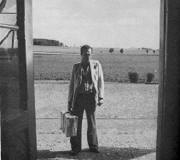
Figure
1
‘Kings of the Road’
|
|
Symbolization of architecture as a tool for the film can be considered as a
characteristic of Wenders’ cinema. His use of space is symbolic.
Space in his films symbolizes some aspects of the film or the story,
especially the society. In his road films such as ‘Alice in the Cities’
(1974), ‘Kings of the Road’ (1976) and ‘Paris, Texas’ (1984),
the city is the symbol of the modern man who ‘lost touch with the world’
and the road is the symbol of the ‘moving man’. His characters prefer
moving and leaving to staying (figure 1).
Moving is a way of living. It is what being at home means. It is not only
his characters who move. Wenders states he himself can work only when he
travels.
When used as a symbol, space is treated as a basic element of the film like
an actor, script or music where the treatment is functional. In other words,
here space, which is in the foreground, is a tool to convey the message. It
helps the visualization of narration. The representation of space is mostly
physical (audiovisual) in character whereas the use of space is generally
symbolic or metaphorical. Space symbolizes things such as a person, an event
and a situation for narration. Meanings are represented by symbolized
architectonic elements.
Space in Wenders’ cinema has a social character as well. His approach
to space, film and life is social. He uses cinema to express his
understanding of society. For him, space is part of the chaotic social life
and is the reflection of the society. Instead of its physical form, he
focuses on the social aspect of architecture, on its place in people’s
lives. His aim is to tell how he sees people and the society using space
(human - space relations). That is the way he represents space in film.
Wenders’ approach to space, as to film, is selective. “It is a
selective landscape that we see,” (Harvey, 1990: 316). He selects and
analyzes a particular space and turns it into a symbol. He selects pieces
out of the chaos of architectural space, frames them due to his aim,
transforms them using the possibilities of the medium of cinema and forms an
order. Space in Wenders’ films is a visual tool for the story.
Both spaces and spatial experiences are designed in Wenders’ films. He
prefers using real (existing) spaces (road, city) to film sets. The
interior spaces represented in Wenders’ films are not many in number; they
usually are cold, ordinary hotel rooms, cafes and gas stations. They are
always instantaneous, temporary and foreign. Hotel is the space for a break;
Wenders himself writes and evaluates there.
Unlike architecture, both space and time are designed in the medium of
cinema. As for the films of Wenders, time is usually linear like the
movement of his characters on the road. Film is like a journey that starts
in the beginning of the film and ends in the end. Architectural space that
is continuous by nature becomes discontinuous in Wenders’ films as in
almost all films. Framed pieces of space are recontextualized through
montage. Normally cinema flattens space. It carries architectural space from
three-dimensionality to two-dimensionality. However, at the same time,
cinema creates the ‘impression’ of the third dimension which is depth.
Wenders’ camera usually tries to create the sense of depth.
There are several techniques and elements that the director uses in the
representation of space in his films. He uses most of them in every film.
The possibilities and limits of his symbolic/social space are analyzed
through these techniques and elements in his films.
Spatial techniques
Use of movement: Space is in motion in Wenders’ films, especially in
his road films. He prefers using mobile frames, and space gains dynamism.
Characters are never ‘there’; they pass by; they move through
spaces. Space is perceived while moving. The camera moves to keep something
mobile in sight such as a plane, a flying bird or a boy riding his bicycle.
Moving is a way of living. Wenders shows us a new way of perceiving space.
Use of black and white: Wenders prefers black and white films to
colored ones. While shooting Hammett (1978-1982), his first film in
the United States, he was not allowed to use black and white, therefore he
made the darkest film ever. The use of black and white together with color
as a technique to represent space dominates in ‘Der Himmel über Berlin’.
Use of light: Wenders usually uses natural light (daylight) or city
lights, especially on the road. Nothing but light, such as the neon lights
of a hotel or a city, is perceived while driving at night.
Framing: Wenders uses cinematic frame to (de/re)contextualize space.
He uses a framed piece of space which is detached from its context to create
new architectural or cinematic meanings. Wenders selects spaces with his
mobile camera. The space continues behind the frame. For this reason, space
in his films is the totality of onscreen and offscreen space.
Superimposition of images: Wenders superimposes and juxtaposes images
within the cinematic frame in ‘Notebooks on Clothes and Cities’ (1989). In
this ‘diary-movie’ that is about a Japanese fashion designer living in
Paris, the juxtaposed images represent the process (sewing a dress that is
tried on by a model), the product (fashion show) and the theory of design
(the designer’s words) at the same cinematic moment. The shape and the
location of the frames on the screen match with the content of the frames.
Spatial
elements
|
|
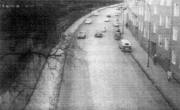
Figure 2
‘The State of Things’
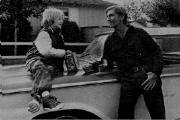
Figure 3
‘Paris, Texas’

Figure 4
‘Paris, Texas’

Figure 5
‘Kings of the Road’
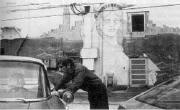
Figure 6
‘Paris, Texas’
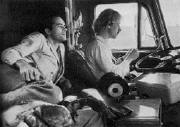
Figure 7
‘Kings of the Road’
|
|
Road: A significant characteristic of Wenders’ cinema is his road
films. Most of his films take place not in the city but on the road - not
in but through a space (figure 2).
The road keeps characters away from the nastiness of settled life.
Characters belong to the road, not to the city. The road represents
‘seeking’ (figures 3, 4).
City: Road films turn out to be city films through Wenders’ camera.
Cities are like balloons attached to the edges of roads. They are for a
break while passing by. Not the elements – cities – but the relations –
roads – between them are emphasized. A city is represented simply as a road
and a void framed by the facades of the buildings along the road. Buildings
are the two-dimensional décor of the road as in Westerns (figure
5). In ‘Alice in the Cities’, cities instead of countries are in
the foreground. All the American cities look the same except New York that
has an identity with its high-rise buildings.
Vehicle: Characters – and the viewer – experience the city in a
vehicle in Wenders’ films. The camera frames the road and the city in motion
through the window of a vehicle such as a car, a train, a plane, a bus, a
boat, a bicycle or a ferry (figure 6).
There are public and private vehicles just like public and private spaces.
Private ones are usually ‘mobile homes’, for instance a caravan (figure
7). In his article about mobile homes Greg Metcalf mentions the
ones in ‘State of Things’, ‘Paris’, ‘Texas’ and ‘Der Himmel
über Berlin’.
Wenders’ techniques and elements of space not only turn space into an actor
but also make space a symbol of contemporary society. The changing character
of architectural space is questioned. Wenders’ way of representing space can
be considered as a tool for architects to analyze the social aspects of
space.
|
| |
|
‘Der Himmel
über Berlin’ (‘Wings of Desire’)
The king of the road wants to mount the
stairway to heaven.
Phillip Kolker and Peter Beicken (1993: 160)
Following the introduction about Wenders’ film space, the director’s
thirteenth feature film will be studied in detail to go further on the
subject. ‘Der Himmel über Berlin’ that he made in Germany in 1987 is a story
of the city of Berlin and an angel in the city who wants to be a human
being. Space is a symbolic tool for story-telling in this film.
Berliners are not the only inhabitants of the city in ‘Der Himmel über
Berlin’.
Other than humans, angels live in the city. They are not visible to humans
but children notice them, yet in the next moment they forget about them. One
of these angels, Damiel, makes up his mind to become a human. He shares his
desire with his partner, Cassiel. Meanwhile he falls in love with a trapeze
artist, Marion, who works in a circus. According to an interpretation,
because of love, probably because of great desire his wish “to come
inside” (Harvey, 1990: 319) turns out to be true. There are two other
characters that are successfully integrated into the film, Peter Falk (as
Peter Falk) and Homer. Falk, who was an angel once, is in Berlin to act in
an American film about the Nazi period. Homer as the story-teller, on the
other hand, looks for his listeners who became readers far away to tell them
the past of Berlin. The ‘hi(story)’ must be remembered. “Homer is the
representative and bearer of collective memory, the spirit of history. He is
also the spirit of Berlin, who laments the vanishing of the city in the war,”
(Kolker and Beicken, 1993: 151). It is a pity that such an inspiring film
has been reduced to a love story in the last scenes (with Marion’s
theatrical monologue).
In one of the scenes, the viewer sees a raving man about to die near a
bridge. As the man raves (as his thoughts swing in his mind), the camera
swings like a pendulum, and as it swings, the viewer sees the parapet on one
side of the bridge and then the other. The changing perspective of the
bridge as the camera swings emphasizes the thoughts flying in the mind of
the dying man, and it seems to symbolize his journey between life and death.
This scene is a good example of ‘space as symbol’ where space
is a tool to visualize and support what the director wishes to express.
There are two reasons for using the German title ‘Der Himmel über
Berlin’ in this text instead of the English ‘Wings of Desire’. One reason is
that Berlin has a very important role in the film: As Harvey states “it
is a pity that
Berlin
disappears from the English title because the film is a wonderful and
sensitive evocation of the sense of that place,”
(1990: 314). The other reason is the double meaning of ‘Himmel’, sky and
heaven: As Wenders says, “In German the word ‘Himmel’ means both sky and
heavens so it was almost like a little poem, a little haiku,” (Paneth,
1988: 4). About shooting the film in Berlin, Wenders says:
It is the first time I made a film in one place. I really used to think I
was able to work only while I was on the road. It was scary to stay in one
place. But it wasn’t difficult at all, because there was a lot of other
movement. There was a strange movement in time which felt almost like a
journey. Of course, the film was not linear, like the other movies I’ve
made, where there was an itinerary. They always had horizontal movements.
‘Wings of Desire’ is my vertical road movie (Fusco, 1988: 16).
Wenders explains the origin of his angels as follows: “First
and foremost,
[Rainer
Maria]
Rilke’s ‘Duino Elegies’. Paul Klee’s paintings too. Walter Benjamin’s ‘Angel
of History’. There was a song by the Cure that mentioned ‘fallen angels’,
and I heard another song on the car radio that had the line ‘talk to an
angel’ in it,”
(1991: 77). Wenders’ angels cannot feel but they hear any sound, even the
thoughts of humans. Life, for them, is to walk around and to collect
knowledge. They watch humans. Humans, on the other hand, ‘feel’, do not
‘watch’. They ‘live’ any aspect of life with their feelings. Angels cannot “get
inside the problem of human decision-making;” they “can never really
participate, only pretend,” (Harvey, 1990: 315). As Harvey says, “Being
outside human space and time, all the angels can do is to offer some
spiritual comfort, try to soothe the fragmented and often shattered feelings
of the individuals whose thoughts they monitor,” (1990: 315). Angels are
assumed to know everything. Humans, on the other hand, have the capacity of
'guessing' instead of 'knowing'. “Perhaps the ‘all-seeingness’ of the
angels was truer than the colorful, three-rather-than-four-dimensional
vision,” (Wenders, 1991: 82).
Angels see the world through “monochromatic eyes” (Harvey, 1990:
315), whereas humans have a colored world. The “use of color
changes to denote changes of viewpoint” is impressive in the film
(Green, 1988: 129). “They
[Angels]
know this place from time immemorial, and they are intimately acquainted
with its history,”
(Green, 1988: 128). Wenders says “the angels were a metaphor for history
and the memory of it,” (Fusco, 1988: 16). They are the witnesses of the
whole history of Berlin as Wenders states:
They
[Angels]
were there before the city was there, when there were still glaciers. They
saw the city being built, they saw Napoleon come through. They saw the city
being destroyed. They saw it all go down the drain. They saw it at its most
terrifying, as the capital of fascism. They are witnesses.
(Fusco, 1988: 16).
In ‘Der Himmel über Berlin’, angels and humans are the users of
space – any space within the city. They conceive the world, life, time
and space in their own ways. Angels are always everywhere, whereas humans
are at a single place at a certain time. Harvey mentions “the
monochromatic landscape of eternal time and infinite but fragmented space”
(1990: 321) of angels saying “[t]he
picture of Berlin that emerges from their perspective is an extraordinary
landscape of fragmented spaces and ephemeral incidents that has no binding
logic,”
(1990: 315). Contrary to Harvey’s idea about the fragmented space of the
angels, the world is an unbroken, undivided space with the angelic
perception, just like the perception of children (world as one). However,
humans have “a totally different mode of spatial experience” (Harvey,
1990: 319); their world is broken into pieces. “In ‘Wings of Desire’, we
similarly encounter two groups of actors living on different time scales.
Angels live in enduring and eternal time, and humans live in their own
social time and, of course, they each see the world very differently,”
(Harvey, 1990: 314). Angels do not have limitations of space and time
just like memory and cinema. But, humans have 'now' instead of ‘always’,
'here' instead of 'anywhere'. Harvey says (1990: 315):
They
[Angels]
can also move effortlessly and instantaneously in space. For them, time and
space just are, an infinite present in an infinite space which reduces the
whole world to a monochromatic state. Everything seems to float in the same
undifferentiated present.
The spaces
In ‘Der Himmel über Berlin’, specific elements in different scales are
defined for the representation of architectural spaces in Berlin; these are
the city, the Wall, the library and the circus. Berlin has a scale
which belongs to a city, the Wall is also in urban space scale, and the
library is represented in interior space scale, whereas the circus is in
both building scale and interior space scale. They are perceived sometimes
in black and white through the eyes of angels, sometimes in color through
the eyes of humans.
Berlin forms the general framework of the film. It is a symbol of
the fragmented postwar life which includes all other symbols driven in the
film. The Wall symbolizes the transition from the past to the present which
is made clear throughout the film. It is a symbol of the war. It is always
onscreen proving that it is constantly a part of life in Berlin. The library
and the circus are mirrors of life, the former, of permanent aspects, the
latter, of temporary ones. The library is a symbol of history, including
collected memory and the knowledge of mankind that is permanent all the
time. The circus is a symbol of identity, human relations and belonging to a
place, that are the positive aspects of life, and it shows the temporariness
of these concepts. A detailed analysis of each of these spaces will follow.
Berlin
In ‘Der Himmel über Berlin’, the first thing that is framed is the city.
The film cannot be shot somewhere else, it is setting based. Wenders says, "The
thing I wished for and saw flashing was a film in and about
Berlin. A
film that might convey something of the history of the city since 1945,"
(1991: 73). Wenders analyzes the city of Berlin as a Berliner who look at
the city from the outside but still as an insider: “All the other films I
made in
Germany
were about trying to get out of the place. This time I still had the point
of view of an outsider, but I tried to look in,”
(Fusco, 1988: 14). After Germany, Wenders made films in the United States
and this is his first film back in his country as someone who can look in
from the outside, like the angels. The director has a poetic description for
Berlin and his film (1991: 74-76):
And so I have 'BERLIN'
representing 'THE WORLD'.
I know of no place with a stronger claim.
Berlin is 'an historical site of truth'.
...
Berlin is divided like our world,
like our time,
like men and women,
young and old,
rich and poor,
like all our experience.
...It's more a SITE than a CITY.
...
My story isn’t about Berlin
because it is set there,
but because it couldn’t be set anywhere else.
The name of the film will be:
THE SKY OVER BERLIN
because the sky is maybe the only thing
that unites these two cities,
...
with a common past
but not necessarily a shared future.
And what of the present?
That is the subject of the film:
THE SKY OVER BERLIN
OVER BERLIN?,
in, with, for, about Berlin . . .
What should such a film
'discuss', 'examine', 'depict', or 'touch on'?
...
ONE story about DIVISION
...
In the film of course it’s not HISTORY
but A story, though of course
a STORY may contain HISTORY,
images and traces of past history.
...
"Wenders'
‘symphony
of a great city’
is conducted from on high," (Kolker and Beicken, 1993: 144). The film
starts with views of Berlin from the air with "the aerial point of view of
the angel" (ehrlich, 1991: 242), as a
representative of urban space scale. "[T]he
camera takes angel flight, gliding through the Berlin cityscape,"
(Kolker and Beicken, 1993: 143). In the second set of images, the camera
zooms in a “nineteenth-century worker housing” (Harvey, 1990: 315),
which can be considered as a representative of building scale. Robert
Phillip Kolker and Peter Beicken emphasize “an ‘objective’ observation of
an urbanity strained by the conflicting and violent demands of the middle
and working class,” (1993: 143). As the third set of images, the camera
enters the housing through a window showing the rooms of apartments, as a
representative of interior space scale. Wenders’ camera is “swooping from
great heights, entering apartment rooms, wandering and drifting through the
city, making divine cinema," (Kolker and Beicken, 1993: 144). These
lonely private apartment rooms are the first representatives, in the film,
of the divided spaces of Berlin.
In ‘Der Himmel über Berlin’, Berlin is represented both as a very
specific city and as one of the many metropolises. Wenders says “Berlin,
the divided city of course, was just another metaphor, like the angels
themselves. Berlin seems to be a city that well represents not only Germany,
but also our civilization. In a way, Berlin really represents the world,”
(Fusco, 1988: 16). It is framed as a cosmopolitan city of 1987 with
people belonging to different nations and speaking (and thinking in)
different languages. Berliners are not only Germans (as Hitler wished) but
also people from all over the world. Les Caltvedt says, “The city is also
home (or “home”) to foreigners; ... she
[Marion]
feels most at home because she is a foreigner”
in Berlin (1992: 122). Linda Ehrlich says (1991: 244):
‘Wings of Desire’ reaches toward universality within the specific
geographical and historical framework of postwar
Berlin.
Characters speak German, French, English, Hebrew, Japanese, Turkish –
sometimes without subtitles – which places the viewer right in the middle of
a cosmopolitan urban setting where no one in real life offers subtitles.
In the film, the space of the city of Berlin can be seen as divided into a
foreground and a background. In the foreground, one may see the divided
postwar city of 1987 and in the background, there is the city of ruins from
1945. Two visions are superimposed in the film; the living, therefore
changing Berlin-of-the-80s and the frozen image of
Berlin-of-the-40s that is constant in all sequences, “an idea of
juxtaposing and superimposing today’s Berlin and the capital of the Reich,
‘double images’ in time and space” (Wenders, 1991: 77). Contemporary
Berlin is in the consciousness while the frozen image as the result of the
break in 1945 is in the subconscious of the actual city. Wenders says, "Behind
the city of today, in its interstice or above it, as though frozen in time,
are the ruins, the burned chimneystacks and facades of the devastated city,
only dimly visible sometimes, but always there in the background,"
(1991: 79-80). Through Wenders’ camera “the former capital” (Paris:
1993, 238) runs after the present. “[T]he
hi(story) that elsewhere in the country is suppressed or denied is
physically and emotionally present here,"
(Wenders, 1991: 74). Time passes but Berlin-of-the-40s persists. He says "this
yesterday is still present everywhere, as a 'parallel world'" (Wenders,
1991: 80) which is visible to the angels in the film as well as to
Berliners. Peter Green says (1988: 128):
Wenders’
Berlin,
destroyed by the war, ravaged by subsequent reconstruction and torn apart by
the Wall, which has turned the very heart of the city into a peripheral
zone, is a picture of a waste land littered with the ruins of the past and
the cold concrete of postwar developments. Here Wenders resumes his search
for time and place. Berlin functions both as a backdrop against which the
other layers of his film are set, and as the living tissue through which
Curt Bois wanders, a Homeric commentator in pursuit of the city’s lost
identity.
Wenders finds flashback unsafe for the temporal and spatial unity of a film
(Lewis, 1984: 51). For this reason, he uses two ways, other than flashback,
to go back in time and visualize Berlin-of-the-40s in ‘Der Himmel
über Berlin’. As the first way, a film that represents 1945 is shot, and as
the second, angels who have no temporal limitations jump from 1987 to 1945.
In the film, “an American crew, including Peter Falk, makes a film about
wartime
Berlin,”
(Caltvedt, 1992: 122). In the “film-within-the-film,” (Paneth, 1988:
2) there are soldiers in Nazi uniforms and Falk’s ‘extra people’, the
Jewish. By using the images of a film set representing the Nazi period that
is a ruined “multi-leveled air raid shelter” (Ehrlich, 1991: 244)
with a hole in the middle of the slab, Wenders does not flash but goes back
to Berlin-of-40s. On the other hand, he uses “documentary material and
film in film to create shifts in time” (Green, 1988: 129). Through “old
newsreel footage of wartorn
Berlin and
Nazism,”
(Paneth, 1988: 2), “the past dissolves into the present, and back again,”
(Ehrlich, 1991: 245). Kolker and Beicken describe one of the “street
scenes that conjure up images of war-time destruction” (Harvey, 1990:
316) as follows:
This sequence follows Cassiel’s car ride through
Berlin,
during which old footage of the last months of the war and the rubble of
bombing raids... Cassiel sees past and present, and in voice-over he
meditates upon history and the German spirit, its lack of individuality and
sense of spiritual community
(1993: 153).
|
|
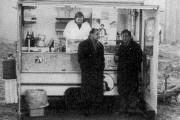
Figure
8
‘Der Himmel über Berlin’ |
|
In Wenders’
film, specific spaces that are represented as parts of the city help
“the exciting rediscovery of
Berlin”
(Paris: 1993, 238). These spaces which are represented as fragments within
the framework of Berlin are the Potsdamer Platz – the old city center,
Kaiser Wilhelm Memorial Church, Victoria’s statue, and the outdoor snack
wagons that stand in the middle of the ruined parts of the city (figure 8),
the caravan, the bar and the laundromat. “After years of filming on the
road” (Fusco, 1988: 14), Wenders cannot eliminate the streets of
Berlin as well. The viewer finds himself experiencing space in moving
vehicles such as cars, subway trains, ambulances or “on the upper level
of an empty double-decker bus" (Ehrlich, 1991: 245). Caltvedt says
(1992:124):
In ‘Wings’,
it seems that the street further distinguishes between the “blessed”
(angels, former angels, aerialists, and children) and the others. Peter Falk
enjoys Berlin the most on the street... The angel Damiel begins his new
human life on the street. ... The street – covered by the sky – is the
primeval shelter where people can encounter one another.
In Berlin, humans live on the street, whereas the angels are free from
vertical and horizontal boundaries, from the limitations of space and time.
"[A]
transcendent, 'timeless' city for the actual Berlin of today"
(Wenders, 1991: 81) is present for the angels. When the angel, Damiel,
became human, he 'traveled' from the angels'
Berlin
to the humans'
Berlin,
the former being a three-dimensional totality and the latter a lonely,
hopeless labyrinth, the collage of worlds rejecting one another. The angel,
in this transformation, is represented as a transition element from the
imaginary to the real, from the permanent to the temporary, from the world
as one to the world in pieces, from eternity to today, from anywhere to
here, from a black and white world to a colored one.
Wenders’ Berlin is symbolic; he interprets Berlin as a symbolic
site: “No other city is to such an extent a symbol, a place of survival.
It is a site, more than a city,” (Paneth, 1988: 2). “Combining
allegory and document, striking cinematography and multilayered sound,
Wenders offers a lyrical reflection on German history and culture that
transforms Berlin into a rich symbolic landscape,” (Fusco, 1988: 14). “The
film explores this wideanging significance:
Berlin as a
symbol of the post-World War II world order, of borders, no-man’s land,
desire and, most of all, of German history and Nazism,”
(Paneth, 1988: 2).
Moreover, Wenders shifts space to a social level in ‘Der Himmel
über Berlin’. He focuses on the social aspect of the city and architecture
and their place in people’s lives instead of their physical aspects. The
city is a part of the chaotic social life and is the reflection of society.
He visualizes his perception of the society by using the city as a social
tool. He says, “I didn’t want just to make a film about the place,
Berlin. What I wanted to make was a film about people – people here in
Berlin – that considered the one perennial question: how to live?”
(1991: 74). The film not only shows the two superimposed visions of Berlin,
but also reflects the psychology of its citizens. For him, the city and its
citizens compose an inseparable whole, transform one another; the stories of
the citizens form the history of the city. The city is treated like a living
organism which gets shape with the social life in it.
The wall
The Berlin Wall is a continuous horizontal concrete structure, lying
between West Berlin and East Berlin, constructed in August 1961 to prevent
transition between the two. There exists “the no man’s land between two
lines of the
Berlin
Wall, patrolled by soldiers”
(Harvey, 1990: 319). The inner faces of the Wall are gray in color, while
the face on the west side has colorful graffiti of human faces in big
scales. The eastern face is never onscreen. The Wall is not too high, but it
is impossible to see the other side. It was demolished in 1989, two years
after the production of the film. Ehrlich says “the
Berlin Wall
which forms another leitmotif”
perpetually repeats itself in the film (1991: 243). The Wall can be seen as
an object, as a divider, as a barrier, as a landmark, as a frame and as a
symbol in ‘Der Himmel über Berlin’.
The Wall as an object: The Wall “which the film continually
runs up against” (Paneth, 1988: 2) is an architectonic element within
the city. It is always with you in Berlin. It is in the foreground.
The Wall as a divider: First, the Berlin Wall was a boundary
between two pieces of a big city. Now it is between two different cities.
The Wall as a barrier: The transparency of the Wall for angels
emphasizes its solidity for humans. The Wall “has never previously been a
barrier to” the angels (Wenders, 1991: 82). Wenders says "with angels
you could do anything, there were connections all over the place, you can go
anywhere. You could cross the Wall, pass through windows into people’s
houses," (1991: 109); “they can slip through the Wall,” (Green,
1988: 129). But the Wall means neither transparency nor continuity for
humans. They cannot pass it, cannot see the other side. It is an element of
division and separation.
The Wall as a landmark: Wenders says, “The Wall has been there
for such a short period of time compared to the time they
[angels]
have been there. They are not impressed,”
(Fusco, 1988: 16). But for humans, the Wall is a landmark. “‘It is
impossible to get lost in
Berlin,’
someone says, because you can always find the wall’,”
(Harvey, 1990: 316).
The Wall as a frame: The aim of the Wall was to divide Berlin
into two but its construction broke the city not merely into two, but into
many pieces. Today the Wall does not exist, but its essence lies within the
fragmented city.
The Wall as a symbol: The Wall is a symbol and a reminder of the
war, and a part of the memory of the 1940s. It symbolizes the transition
from the past to the present. It is the three-dimensional representation of
the city in pieces. Harvey says (1990: 316):
The distinctive organization of space and time is, moreover, seen as the
framework within which individual identities are forged. The image of
divided spaces is particularly powerful, and they are superimposed upon each
other in the fashion of montage and collage. The
Berlin Wall
is one such divide, and it is again and again evoked as a symbol of
overarching division. Is this where space now ends?
The library
|
|

Figure
9
‘Der Himmel über Berlin’ |
|
In the film, the library, Berlin Public Library (Kolker and Beicken, 1993:
142), is represented in interior space scale. It is a mystical space (music,
murmuring) with huge slander white columns, high ceilings and an atrium with
a large staircase in the middle that unites the space within the library (figure
9).
It is wide and spacious. A part of the roof is made of glass, and there are
balcony-like projections of the gallery. Light comes from big circular
sources on the ceiling. Even in this single space, humans are alone, each
sitting and reading at a table with its own lamp. It is peaceful and calm,
mysterious and innocent. Everything is in silence except the collected
knowledge which is the source of evaluation. Wenders describes the space as
follows (Paneth, 1988: 6):
I thought this is a heavenly place, a library, ... it’s really a wonderful
place, with a lot of light, and built with a lot of respect for reading and
books, and also so peaceful and quiet. There is also the whole memory and
knowledge of mankind united there.
Books are the documents of history and the library is the home of books. It
is the disorder of the orderly. Formally it is in order, but contextually it
is completely in disorder. It is the chaotic crowd of pieces of collected
memory and it helps to picture the whole history by connecting these
pieces. It is a timeless space belonging to history. Paneth says “I
thought the handwriting at the beginning and the end and the library were
wonderful gestures toward the written word,” (1988: 6). The library, as
Kolker and Beicken describe, is "the archive of human memory" (1993:
149). It is for reading, for remembering, for thinking, for questioning, for
searching, for learning, for understanding and for knowing. It is the museum
of the knowledge of the past. Caltvedt refers to this “otherworldly space”
as follows (1992: 124):
Another “felicitous space” is the state library, which houses angels, a
man called Homer, and anonymous patrons. The soundtrack, the angels, the
postures of the readers all suggest sacred space. ... The library contains
in spirit the whole universe, and guides the viewer initiate to the written
word (in the beginning was the Word), “heavenly” music, a small flock of
angels who hang around in the stacks, humankind’s photo album (August
Sanders’s anthropological collection, Citizens of the Twentieth Century) and
a whole collection of globes.
|
|
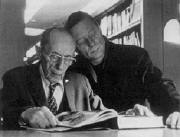
Figure 10
‘Der Himmel über Berlin’ |
|
The
story-teller is related to the library in the film. Wenders says “we had
Homer living in a library,” (1991: 112); “he uses the library to try
and recuperate a proper sense of the history of this distinctive place
called
Berlin,”
(Harvey, 1990: 317). But the real inhabitants of the library are the
angels (figure 10). It is the “headquarters
for the celestial beings” (Paris, 1993: 238). Wenders thinks of the
library as “a place in the city where the angels would live, would be at
home,” (Paneth, 1988: 6). “In their nocturnal haunt in the
depopulated library they appear drained in the monochromatic light, trapped
in an exquisitely isolated perfection,” (Ehrlich, 1991: 245). Kolker and
Beicken say that "it is a brilliant conceit to present the library as the
gathering place of the angels," (1993: 149) maybe because it is really a
timeless space. Are there really so many angels in a library?
The
circus
|
|
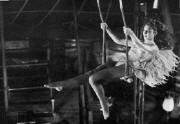
Figure 11
‘Der Himmel über Berlin’ |
|
In ‘Der Himmel über Berlin’, the circus is represented first from the
outside framed by the ruins of the city in building scale. Green claims “through
a gateway one suddenly catches a magical glimpse of an elephant and a circus
in the heart of the city,” (1988: 129). Through this frame-within-frame
the circus is perceived as a big circular pavilion made out of tent canvas.
It has a column in the center which is raised till the top point of the
ceiling; the circus is a juxtaposition of a cone above a cylinder. Then the
camera goes in and records the circus in interior space scale. It is a large
single space. It is round and has stepped seats all around which avoid
hierarchy (where it differs from life). From the center to the periphery,
the seats rise. It has a circular stage in the center where the whole
performance takes place. As the trapezian girl swings (the camera swings too
but more slowly), the viewer perceives the three-dimentionality of the space
in the circus. Marion’s rehearsal is the first colored shot in the film (figure
11).
Wenders says “since the whole film also deals with children, I
thought of a circus,” (Fusco, 1988: 15). "A circus is a privileged
spot because of the presence of children, and with all the waste ground in
Berlin there is always a circus there," (Wenders, 1991: 111). The circus
is a space where the show represents situations belonging to life such as
difficulty, comedy, magic and danger. It is a mirror of the positive
aspects of life. Nothing goes wrong there. It is for fun and
entertainment. It is the space for the imaginary, the instant, the temporary
and the extraordinary. It is an image of things belonging to or concerning
life, whereas the viewer’s relation with real life is broken in the circus,
as it is the case while watching a film.
The circus arrives at a place but it always leaves as well. Because of
its mobile Nomadic life it is never ever-lasting; it is always temporary.
It is a guest in the city, not a part of it. It does not belong anywhere.
Even the material of the round tent is not durable. Mentioning the circular
trace of the circus on the ground Ehrlich says “’Wings of Desire’ is full
of both abstract and concrete circular images: The circus ring, finally
reduced to a circle of sand in a field when the bankrupt circus is forced to
pull up stakes,” (1991: 245). “The circus tent is, while the circus
survives, the felicitous space of
Marion’s
art...
[T]he
angel Damiel returns to the circle of sawdust that remains; the power of the
tent seems to linger,”
(Caltvedt, 1992: 124). “The circus ... starts as a place of respite for
the angels, a counterbalance to the dark abyss of the past, but becomes the
scene of Damiel’s transfixion and transition,” (Kolker and Beicken,
1993: 155).
“How can some sense of identity be forged and sustained in such a world?
Two spaces assume a peculiar significance in this regard. The library – a
repository of historical knowledge and collective memory – is a space into
which many are evidently drawn (even angels seem to take their rest there),”
(Harvey, 1990: 317). “But there is a second site where a fragile sense of
identity prevails. The circus, a spectacle held together within the enclosed
space of a tent, offers a venue of special interaction within which some
kind of human relating can go on,” (Harvey, 1990: 318). Hope
still exists in the circus. The feeling of space, time, identity and place
are present. The circus is the result of the nature of its own life. It is a
timeless and international space with no style. But any circus is “a
soon-to-be-disbanding” one (Paris, 1993: 238). Migration never ends and
hope never stays.
|
|
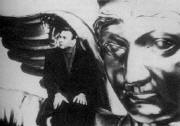
Figure 12
‘Der Himmel über Berlin’ |
|
It can be
stated that Wenders' films make the viewer think about specific spaces such
as ‘city’, ‘library’ and ‘wall’. Wenders makes the viewer think about the
typologies of spaces he represents. He examines their meanings. He
thinks of the essence and the character of these spaces. Representing a
different approach to specific spaces, Wenders’ analysis show architects a
way in understanding particular spaces (figure 12).
As in Wenders’ cinema, films in which space is in the foreground suggest
different ways to perceive, experience and interpret the represented
architectural space. This can expand the perspective of the viewer including
the architect. (De/re)contextualization gives cinema the opportunity
to approach to space through different ways. Architecture is contextual and
is (de/re)contextualized in cinema by using framing and montage. As the
result of (de/re)contextualization, cinema focuses on aspects of space that
are hard to be perceived while looking at the whole within a context and
creates secondary meanings. Architects may learn a lot about architectural
space through its representation in cinema.
Citation
Bowman, Barbara, 1992. “Introduction: Space in Classic American Film,”
Master Space: Film Images of Capra, Lubitsch, Sternberg, and Wyler,
Greenwood Press, New York, Westport, Connecticut, London, pp. 1-11.
Caltvedt, Les, 1992. “Berlin Poetry: Archaic Cultural Patterns in Wenders’
‘Wings of Desire’,” Literature / Film Quarterly, vol. 20, no. 2, pp.
121-126.
Carroll, Noel E, 1988. “The Cinematic Image,” Mystifying Movies: Fads and
Fallacies in Contemporary Film Theory, Columbia University Press, New
York, pp. 89-146.
Ehrlich, Linda C, 1991. “Meditations on Wim Wenders’s ‘Wings of Desire’,”
Literature / Film Quarterly, vol. 19, no. 4, pp. 242-246.
Fusco, Coco, 1988. “Angels, History and Poetic Fantasy: An Interview with
Wim Wenders,” Cineaste, vol. 16, no. 4, pp. 14-17.
Green, Peter, 1988. “Germans Abroad,” Sight and Sound, vol. 57, no.
2, pp. 126-130.
Harvey, David, 1990. "Time and Space in the Postmodern Cinema," The
Condition of Postmodernity - An Inquiry into the Origins of Cultural Change,
Basil Blackwell Ltd., Massachusetts, pp. 308-323.
Kolker, Robert Phillip, and Peter Beicken, 1993. The Films of Wim Wenders:
Cinema as Vision and Desire, Cambridge University Press, Cambridge.
Lewis, Brent, 1984. “Wim Wenders ile Söyleþi: Paris, Texas,” Geliþim
Sinema, November, vol. 2, pp. 50-51.
Metcalf, Greg, 1993. “The Other Kind of Movie Trailer: Mobile Homes in
American Movies,” The Material World in American Popular film, Vol. 3
of Beyond the Stars: Studies in American Popular Film, eds. Paul
Loukides and Linda K. Fuller, Bowling Green State University Popular Press,
?, pp. 229-242.
O’Herlihy, Lorcan, 1994. “Architecture and Film,” Architectural Design,
November - December, vol. 64, no. 11/12, pp. 90-91.
Paneth, Ira, 1988. “Wim and His Wings,” Film Quarterly, Fall, vol.
XLII, no. 1, pp. 2-8.
Paris, James Reid, 1993. Classic Foreign Films from 1960 to Today.
Citadel Press, Paris, New York.
Sobchack, Vivian, 1987. “The Deflation and Inflation of Space,” and “The
Collapse and Conflation of Time,” Screening Space: The American Science
Fiction Film, Ungar, New York, pp. 255-281.
Wenders, Wim, 1991. "An Attemped Description of an Indescribed Film," and
“Wings of Desire," The Logic of Images: Essays and Conversations,
Faber and Faber, London, Boston, pp. 73-83, 109-113.
Figure
references
Figure
1.
Paris, Classic Foreign Films, 160.
Figure 2.
Kolker and Beicken, The Films of Wim Wenders , 3.
Figure 3.
Videosinema,
85/4, 39.
Figure 4.
Kolker and Beicken, The Films of Wim Wenders, 130.
Figure 5.
Kolker and Beicken, The Films of Wim Wenders, 37.
Figure 6.
Kolker and Beicken, The Films of Wim Wenders, 127.
Figure 7.
Kolker and Beicken, The Films of Wim Wenders, 69.
Figure 8.
Kolker and Beicken, The Films of Wim Wenders, 157.
Figure 9.
Kolker and Beicken, The Films of Wim Wenders, 149.
Figure 10.
Paris, Classic Foreign Films, 237.
Figure 11.
Sight and Sound,
87/3, 169.
Figure 12.
Kolker and Beicken, The Films of Wim Wenders, 139.
Film
credits
’Der Himmel über Berlin’ (‘Wings of Desire’)
(B&W, colour, 35 mm, 127’)
Director: Wim Wenders
Assistant directors: Claire Denis, Knut Winkler, Carola Hochgraf
Screenplay: Wim Wenders, Peter Handke
Cinematographer: Henri Alekan (black and white, Eastman-color)
Assistant cinematographers: Louis Cochet, Agnes Godard, Achim Poulheim,
Peter Ch. Arnold, Martin Kukula, Frank Blasberg, Peter Braatz, Klemens
Becker, Klaus Krieger
Art director: Heide Lüdi
Editing: Peter Przygodda
Assistant editors: Anne Schnee, Leni Savietto-Pütz
Music: Jüngen Knieper, Laurent Petitgand, Laurie Anderson, Crime and the
City Solution, Nick Cave and the Bad Seeds, Sprung aus den Wolken,
Tuxedomoon, Minimal Compact
Cast: Bruno Ganz, Solveig Dommartin, Otto Sander, Curt Bois, Peter Falk
Producers: Wim Wenders, Anatole Dauman
Associate producer: Pascale Dauman
Production company: Road Movies, Berlin; Argos Films, Paris; Westdeutscher
Rundfunk, Cologne
Premiered: 17 May 1987
|
|
|
feedback |
|

Vol. 9, No. 1
November 2004 |

